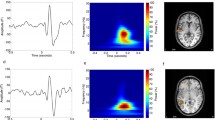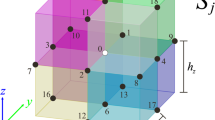Abstract
The accuracy of EEG source analysis reconstruction improves when a realistic head volume conductor is modeled. In this study we investigated how the progressively more complex head representations influence the spatial localization of auditory-evoked potentials (AEPs). Fourteen young-adult participants with normal hearing performed the AEP task. Individualized head models were obtained from structural MRI and diffusion-weighted imaging scans collected in a separate session. AEPs were elicited by 1 k Hz and 4 k Hz tone bursts during a passive-listening tetanizing paradigm. We compared the amplitude of the N1 and P2 components before and after 4 min of tetanic-stimulation with 1 k Hz sounds. Current density reconstruction values of both components were investigated in the primary auditory cortex and adjacent areas. Furthermore, we compared the signal topography and magnitude obtained with 10 different head models on the EEG forward solution. Starting from the simplest model (scalp, skull, brain), we investigated the influence of modeling the CSF, distinguishing between GM and WM conductors, and including anisotropic WM values. We localized the activity of AEPs within the primary auditory cortex, but not in adjacent areas. The inclusion of the CSF compartment had the strongest influence on the source reconstruction, whereas white matter anisotropy led to a smaller improvement. We conclude that individualized realistic head models provide the best solution for the forward solution when modeling the CSF conductor.













Similar content being viewed by others
Data Availability
The datasets generated during and/or analyzed during the current study are available from the corresponding author on reasonable request.
References
Andersson JLR, Sotiropoulos SN (2016) An integrated approach to correction for off-resonance effects and subject movement in diffusion MR imaging. Neuroimage 125:1063–1078. https://doi.org/10.1016/j.neuroimage.2015.10.019
Andersson JL, Skare S, Ashburner J (2003) How to correct susceptibility distortions in spin-echo echo-planar images: application to diffusion tensor imaging. Neuroimage 20(2):870–888. https://doi.org/10.1016/S1053-8119(03)00336-7
Bangera N, Schomer D, Dehghani N, Ulbert I, Cash S, Papavasiliou S et al (2010) Experimental validation of the influence of white matter anisotropy on the intracranial EEG forward solution. J Comput Neurosci 29(3):371–387. https://doi.org/10.1007/s10827-009-0205-z
Basser PJ, Mattiello J, LeBihan D (1994) MR diffusion tensor spectroscopy and imaging. Biophys J 66(1):259–267. https://doi.org/10.1016/S0006-3495(94)80775-1
Bigdely-Shamlo N, Mullen T, Kothe C, Su K-M, Robbins KA (2015) The PREP pipeline: standardized preprocessing for large-scale EEG analysis. Front Neuroinform 9:16. https://doi.org/10.3389/fninf.2015.00016
Birot G, Spinelli L, Vulliémoz S, Mégevand P, Brunet D, Seeck M, Michel CM (2014) Head model and electrical source imaging: a study of 38 epileptic patients. NeuroImage Clin 5:77–83
Buzzell GA, Richards JE, White LK, Barker TV, Pine DS, Fox NA (2017) Development of the error-monitoring system from ages 9–35: unique insight provided by MRI-constrained source localization of EEG. Neuroimage 2017:13–26. https://doi.org/10.1016/j.neuroimage.2017.05.045
Cho JH, Vorwerk J, Wolters CH, Knosche TR (2015) Influence of the head model on EEG and MEG source connectivity analyses. Neuroimage 110:60–77. https://doi.org/10.1016/j.neuroimage.2015.01.043
Clapp WC, Kirk IJ, Hamm JP, Shepherd D, Teyler TJ (2005) Induction of LTP in the human auditory cortex by sensory stimulation. Eur J Neurosci 22(5):1135–1140. https://doi.org/10.1111/j.1460-9568.2005.04293.x
Conte S, Richards JE, Guy MW, Xie W, Roberts JE (2020) Face-sensitive brain responses in the first year of life. Neuroimage 211:116602. https://doi.org/10.1016/j.neuroimage.2020.116602
Delorme A, Makeig S (2004) EEGLAB: an open source toolbox for analysis of single-trial EEG dynamics including independent component analysis. J Neurosci Methods 134(1):9–21. https://doi.org/10.1016/j.jneumeth.2003.10.009
Delorme A, Sejnowski T, Makeig S (2007) Enhanced detection of artifacts in EEG data using higher-order statistics and independent component analysis. Neuroimage 34(4):1443–1449. https://doi.org/10.1016/j.neuroimage.2006.11.004
Eickhoff SB, Paus T, Caspers S, Grosbras M-H, Evans AC, Zilles K, Amunts K (2007) Assignment of functional activations to probabilistic cytoarchitectonic areas revisited. Neuroimage 36(3):511–521. https://doi.org/10.1016/j.neuroimage.2007.03.060
Fillmore PT, Richards JE, Phillips‐Meek MC, Cryer A, Stevens M (2015) Stereotaxic magnetic resonance imaging brain atlases for infants from 3 to 12 months. Dev Neurosci 37(6):515–532. https://doi.org/10.1159/000438749
Gao C, Conte S, Richards JE, Xie W, Hanayik T (2019) The neural sources of N170: understanding timing of activation in face-selective areas. Psychophysiology. https://doi.org/10.1111/psyp.13336
Güllmar D, Haueisen J, Reichenbach JR (2010) Influence of anisotropic electrical conductivity in white matter tissue on the EEG/MEG forward and inverse solution. A high-resolution whole head simulation study. Neuroimage 51(1):145–163. https://doi.org/10.1016/j.neuroimage.2010.02.014
Hallez H, Vanrumste B, Grech R, Muscat J, De Clercq W, Vergult A et al (2007) Review on solving the forward problem in EEG source analysis. J Neuroeng Rehabil 4:46. https://doi.org/10.1186/1743-0003-4-46
Hallez H, Staelens S, Lemahieu I (2009) Dipole estimation errors due to not incorporating anisotropic conductivities in realistic head models for EEG source analysis. Phys Med Biol 54(20):6079–6093. https://doi.org/10.1088/0031-9155/54/20/004
Harris KC, Wilson S, Eckert MA, Dubno JR (2012) Human evoked cortical activity to silent gaps in noise: effects of age, attention, and cortical processing speed. Ear Hear 33(3):330. https://doi.org/10.1097/AUD.0b013e31823fb585
Haueisen J, Tuch DS, Ramon C, Schimpf PH, Wedeen VJ, George JS, Belliveau JW (2002) The influence of brain tissue anisotropy on human EEG and MEG. Neuroimage 15(1):159–166. https://doi.org/10.1006/nimg.2001.0962
Jatoi MA, Kamel N, Malik AS, Faye I (2014) EEG based brain source localization comparison of sLORETA and eLORETA. Australas Phys Eng Sci Med 37(4):713–721
Jung T-P, Makeig S, Humphries C, Lee T-W, McKeown MJ, Iragui V, Sejnowski TJ (2000) Removing electroencephalographic artifacts by blind source separation. Psychophysiology 37(2):163–178. https://doi.org/10.1111/1469-8986.3720163
Lanfer B, Scherg M, Dannhauer M, Knösche TR, Burger M, Wolters CH (2012) Influences of skull segmentation inaccuracies on EEG source analysis. Biomed Tech (berl) 57:623–626. https://doi.org/10.1515/bmt-2012-4020
Lee WH, Liu Z, Mueller BA, Lim K, He B (2009) Influence of white matter anisotropic conductivity on EEG source localization: comparison to fMRI in human primary visual cortex. Clin Neurophysiol 120(12):2071–2081. https://doi.org/10.1016/j.clinph.2009.09.007
Lei G, Zhao Z, Li Y, Yu L, Zhang X, Yan Y et al (2017) A method to induce human cortical long-term potentiation by acoustic stimulation. Acta Otolaryngol 137(10):1069–1076. https://doi.org/10.1080/00016489.2017.1332428
Lopez-Calderon J, Luck SJ (2014) ERPLAB: an open-source toolbox for the analysis of event-related potentials. Front Hum Neurosci 8:213. https://doi.org/10.3389/fnhum.2014.00213
Mears RP, Spencer KM (2012) Electrophysiological assessment of auditory stimulus-specific plasticity in schizophrenia. Biol Psychiatry 71(6):503–511. https://doi.org/10.1016/j.biopsych.2011.12.016
Michel CM, Brunet D (2019) EEG source imaging: a practical review of the analysis steps. Front Neurol 10:325. https://doi.org/10.3389/fneur.2019.00325
Michel CM, Murray MM (2012) Towards the utilization of EEG as a brain imaging tool. Neuroimage 61(2):371–385. https://doi.org/10.1016/j.neuroimage.2011.12.039
Michel CM, Murray MM, Lantz G, Gonzalez S, Spinelli L, Grave de Peralta R (2004) EEG source imaging. Clin Neurophysiol 115(10):2195–2222. https://doi.org/10.1016/j.clinph.2004.06.001
Michel CM, Koenig T, Brandeis D, Gianotti LRR, Wackermann J (2009) Electrical neuroimaging. Cambridge University Press, Cambridge
Morosan P, Rademacher J, Schleicher A, Amunts K, Schormann T, Zilles K (2001) Human primary auditory cortex: cytoarchitectonic subdivisions and mapping into a spatial reference system. Neuroimage 13(4):684–701. https://doi.org/10.1006/nimg.2000.0715
Neugebauer F, Moddel G, Rampp S, Burger M, Wolters CH (2017) The effect of head model simplification on beamformer source localization. Front Neurosci 11:625. https://doi.org/10.3389/fnins.2017.00625
Oostendorp TF, van Oosterom A (1989) Source parameter estimation in inhomogeneous volume conductors of arbitrary shape. IEEE Trans Biomed Eng 36(3):382–391. https://doi.org/10.1109/10.19859
Oostenveld R, Fries P, Maris E, Schoffelen JM (2011) FieldTrip: open source software for advanced analysis of MEG, EEG, and invasive electrophysiological data. Comput Intell Neurosci 2011:156869. https://doi.org/10.1155/2011/156869
Pascual-Marqui RD, Pascual-Montano AD, Lehmann D, Kochi K, Esslen M, Jancke L, Anderer P, Saletu B, Tanaka H, Hirata K, John ER, Prichep L (2006) Exact low resolution brain electromagnetic tomography (eLORETA). Neuroimage 31(Suppl. 1):S86
Pascual-Marqui RD, Lehmann D, Koukkou M, Kochi K, Anderer P, Saletu B et al (2011) Assessing interactions in the brain with exact low-resolution electromagnetic tomography. Philos Trans R Soc Lond A 369(1952):3768–3784. https://doi.org/10.1098/rsta.2011.0081
Pascual-Marqui RD (2007) Discrete, 3D distributed, linear imaging methods of electric neuronal activity. Part 1: exact, zero error localization. Retrieved from http://arxiv.org/abs/0710.3341. Accessed 31 July 2020
Ramon C, Schimpf P, Haueisen J, Holmes M, Ishimaru A (2004) Role of soft bone, CSF and gray matter in EEG simulations. Brain Topogr 16:245–248
Ramon C, Schimpf PH, Haueisen J (2006) Influence of head models on EEG simulations and inverse source localizations. Biomed Eng Online 5:10. https://doi.org/10.1186/1475-925X-5-10
Richards JE (2013) Cortical sources of ERP in prosaccade and antisaccade eye movements using realistic source models. Front Syst Neurosci 7:27. https://doi.org/10.3389/fnsys.2013.00027
Richards JE, Xie W (2015) Brains for all the ages: structural neurodevelopment in infants and children from a life-span perspective. Adv Child Dev Behav 48:1–52. https://doi.org/10.1016/bs.acdb.2014.11.001
Richards JE, Sanchez C, Phillips-Meek M, Xie W (2015) A database of age-appropriate average MRI templates. Neuroimage 124(Pt B):1254–1259. https://doi.org/10.1016/j.neuroimage.2015.04.055
Richards JE, Gao C, Conte S, Guy M, Xie W (2018) Supplemental information for the neural sources of N170: understanding timing of activation in face-selective areas. Retrieved from https://wp.me/a9YKYg-fm. Accessed 31 July 2020
Russell GS, Jeffrey Eriksen K, Poolman P, Luu P, Tucker DM (2005) Geodesic photogrammetry for localizing sensor positions in dense-array EEG. Clin Neurophysiol 116(5):1130–1140. https://doi.org/10.1016/j.clinph.2004.12.022
Sanders PJ, Thompson B, Corballis PM, Maslin M, Searchfield GD (2018) A review of plasticity induced by auditory and visual tetanic stimulation in humans. Eur J Neurosci 48(4):2084–2097. https://doi.org/10.1111/ejn.14080
Shattuck DW, Mirza M, Adisetiyo V, Hojatkashani C, Salamon G, Narr KL et al (2008) Construction of a 3D probabilistic atlas of human cortical structures. Neuroimage 39(3):1064–1080. https://doi.org/10.1016/j.neuroimage.2007.09.031
Smith SM, Jenkinson M, Woolrich MW, Beckmann CF, Behrens TEJ, Johansen-Berg H et al (2004) Advances in functional and structural MR image analysis and implementation as FSL. Neuroimage 23:S208–S219. https://doi.org/10.1016/j.neuroimage.2004.07.051
Tuch DS, Wedeen VJ, Dale AM, George JS, Belliveau JW (2001) Conductivity tensor mapping of the human brain using diffusion tensor MRI. Proc Natl Acad Sci USA 98(20):11697–11701. https://doi.org/10.1073/pnas.171473898
Tucker DM (1993) Spatial sampling of head electrical fields—the geodesic sensor net. Electroencephalogr Clin Neurophysiol 87(3):154–163. https://doi.org/10.1016/0013-4694(93)90121-B
Tucker DM, Liotti M, Potts GF, Russell GS, Posner MI (1994) Spatiotemporal analysis of brain electrical fields. Hum Brain Mapp 1(2):134–152. https://doi.org/10.1002/hbm.460010206
Vatta F, Meneghini F, Esposito F, Mininel S, Di Salle F (2010) Realistic and spherical head modeling for EEG forward problem solution: a comparative cortex-based analysis. Comput Intell Neurosci. https://doi.org/10.1155/2010/972060
Vorwerk J, Cho JH, Rampp S, Hamer H, Knosche TR, Wolters CH (2014) A guideline for head volume conductor modeling in EEG and MEG. Neuroimage 100:590–607. https://doi.org/10.1016/j.neuroimage.2014.06.040
Vorwerk J, Oostenveld R, Piastra MC, Magyari L, Wolters CH (2018) The FieldTrip-SimBio pipeline for EEG forward solutions. Biomed Eng Online 17(1):37. https://doi.org/10.1186/s12938-018-0463-y
Vorwerk J, Magyari L, Ludewig J, Oostenveld R, & Wolters CH (2013) The fieldtrip-simbio pipeline for finite element EEG forward computations in MATLAB: validation and application. T. Paper presented at the International Conference on Basic and Clinical Multimodal Imaging. Geneva, Switzerland
Wendel K, Narra NG, Hannula M, Kauppinen P, Malmivuo J (2008) The influence of CSF on EEG sensitivity distributions of multilayered head models. IEEE Trans Biomed Eng 55(4):1454–1456. https://doi.org/10.1109/TBME.2007.912427
Wolters CH, Anwander A, Tricoche X, Weinstein D, Koch MA, MacLeod RS (2006) Influence of tissue conductivity anisotropy on EEG/MEG field and return current computation in a realistic head model: a simulation and visualization study using high-resolution finite element modeling. Neuroimage 30(3):813–826. https://doi.org/10.1016/j.neuroimage.2005.10.014
Zaehlea T, Clapp WC, Hammc JP, Meyerd M, Kirkc IJ (2007) Induction ofLTP-like changes in human auditory cortex by rapid auditory stimulation: an FMRI study. Restor Neurol Neurosci 25:251–259
Acknowledgements
This research was supported by the National Institute of Child Health and Human Development (NICHD) of the National Institute of Health under award numbers R01-HD18942 and K99-HD102566.
Funding
National Institute of Child Health and Human Development (NICHD) R01-HD18942 and K99-HD102566.
Author information
Authors and Affiliations
Corresponding author
Ethics declarations
Conflict of interest
The authors declare no personal or institutional conflict of interests.
Additional information
Handling Editor: Leon Deouell.
Publisher's Note
Springer Nature remains neutral with regard to jurisdictional claims in published maps and institutional affiliations.
Supplementary Information
Below is the link to the electronic supplementary material.
Rights and permissions
About this article
Cite this article
Conte, S., Richards, J.E. The Influence of the Head Model Conductor on the Source Localization of Auditory Evoked Potentials. Brain Topogr 34, 793–812 (2021). https://doi.org/10.1007/s10548-021-00871-z
Received:
Accepted:
Published:
Issue Date:
DOI: https://doi.org/10.1007/s10548-021-00871-z




